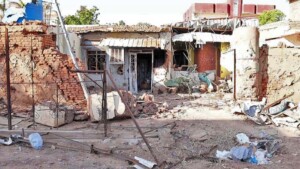New report highlights human and environmental cost of cyanide-based gold extraction in South Kordofan
A new report published by the Sudan Democracy First Group (SDFG) as part of its Sudan Transparency Initiative entitled Cyanide Plants in South Kordofan State: Human Life is a Price for Gold Extraction, highlights the human and environmental costs of the use of cyanide.

A new report published by the Sudan Democracy First Group (SDFG) as part of its Sudan Transparency Initiative entitled Cyanide Plants in South Kordofan State: Human Life is a Price for Gold Extraction, highlights the human and environmental costs of the use of cyanide.
“After South Sudan's independence and the Sudanese government's loss of oil revenues from the South, gold has become a major resource for the country’s budget, and as a result Sudan's gold production has increased steadily. According to the Sudanese Geological Research Organisation, in 2017 gold production reached 105 tons per year,” the report states.
“This volume of production puts Sudan in third place for gold production in Africa, after South Africa and Ghana. Despite this high production and its steady increase, gold production has not stabilised or developed the Sudanese economy. This is largely due to government corruption and mismanagement of the gold mining sector in Sudan, as well as a result of the fact that a substantial percentage of the gold mining activities is controlled by warlords. These realities alongside a resultant loss of confidence in the government’s laws and procedures governing the sector, has led to the spread of traditional mining in Sudan. Traditional mining employs more than two million citizens, producing about 80% of the gold extracted in Sudan.”
Traditional Mining in Sudan and the Use of Cyanide
Traditional mining is carried out by excavating the soil that contains gold. Then the soil is milled and treated with mercury, which extracts about 30% of the gold in the rocks. The left over soil is then treated with cyanide to extract the remaining gold. The waste, or soil left over after the first treatment with mercury, known as “karta”, is moved to factories or labs that belong to companies that purchase the karta from private mines.
This process results in highly toxic industrial wastes, that produces various mineral salts. Traditional miners, small companies and gold labs dispose of these wastes by pouring them directly into valleys and streams, leading to heavy pollution in the environments surrounding the private mining areas, with long term consequences.
Gold mining in South Kordofan
South Kordofan is one the states in Sudan richest in gold. While many companies are involved in mining and their work is regulated by laws and policies on large and medium-sized enterprises, artisan mining is also widespread. According to statistics mentioned by the governor of South Kordofan State, Adam al-Faki, in his statements during his visit to the Bajun mines in the district of Kadeer, some of these are located in the areas of Miri; West Kadogli; East Dalanj; Merifain near Abu Jubayhah; Meridian; Hajjar Zarq and Karn; Alrasaris; Hjayrat and Bardab; Bajun; Al-Nadeef; Qurud; Toro and other areas in the state.
This large number of traditional mines has led to production of large quantities of mercury-treated soils (karta), which in turn encouraged many investors to establish companies and factories specialised in karta treatment, using highly toxic cyanide to extract the remaining gold in the waste. The government of South Kordofan, following a decision from the federal government in Khartoum, granted a number of companies the right to set up cyanide factories in the state, without announcing the names of these companies or their number.











 and then
and then